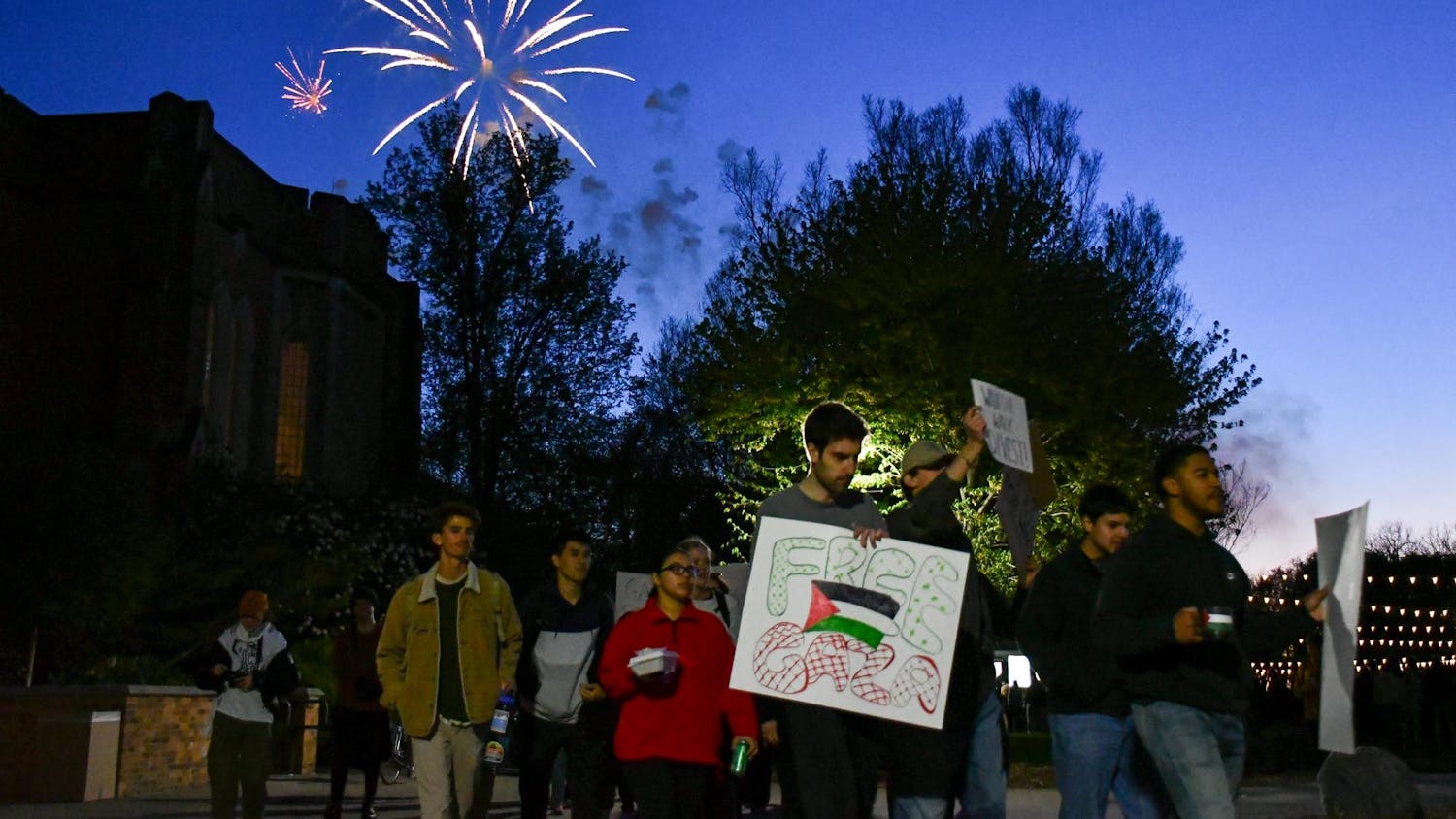Notre Dame has seen a number of substantial changes over the last 10 years. Increases in tuition, applications for admission and research spending have impacted the University just as dramatically as other schools around the nation, while other numbers have stayed fairly consistent since the start of the decade.
Here is a look at how the University has changed since 2010, focusing on tuition, enrollment, demographics, crime, campus infrastructure, research spending and endowment.
Cost of attendance
The past decade included consistent hikes in the cost of admission at Notre Dame.
The cost of tuition increased by 39% since 2010 — more than $15,000 — according to data from the University’s annual reports.
In the fall of 2019, tuition cost $55,046, compared to $39,412 in 2010. Tuition increased by an average of 3.78% each year, and the increase of 3.69% from 2017 to 2018 was the lowest in “more than 50 years,” University President Fr. John Jenkins said.
The average total cost of attendance also increased 39% during the 2010s.
The total cost includes tuition as well as meals, housing, books and fees. The total cost in 2019 is $74,193, Notre Dame’s website stated. From 2010 to 2018, the total cost increased from $53,239 to $71,801, according to the National Center for Education Statistics.
In recent years, Notre Dame has announced tuition changes in February.
The average financial aid award per recipient increased 57% over the decade, according to data provided by the office of financial aid.
In the fall of 2019, the average aid package was $39,603 per recipient, preliminary numbers from the University showed. In 2010, the average award was $25,163. Over 10 years, the average package increased by nearly $15,000.
Overall University scholarship expenditure increased 61%, from $100,852,536 in the 2010-2011 school year to a projected $162,412,534 in the 2019-2020 school year.
Enrollment
Enrollment at Notre Dame has stayed fairly consistent since the beginning of the decade. In the 2010-2011 school year, the University enrolled 8,729 undergraduates and 4,181 graduate students. According to its website, Notre Dame currently has 8,617 undergraduates and 3,990 graduate/professional students.
Admission rates, however, have decreased since 2010, as Notre Dame has seen increasing numbers of applicants. In 2010, Notre Dame reviewed 14,521 applications for the class of 2014 and accepted 29% of those who applied. Nearly 43% of early applicants were accepted from this pool. In 2019, the University received 22,199 applicants for the class of 2023. From that group, 15.8% were admitted, and about 21% of early applicants were admitted.
Director of undergraduate admissions Christy Pratt said the increase in applicants was in line with a nation-wide pattern.
“Applications over the past nine years have been on an upward trend nationally,” she said in an email. “With the advent of application platforms such as The Common Application, The Coalition Application and The Universal Application, students have greater access to multiple colleges and universities.”
The Gateway Program was founded in 2013, and consisted of 17 students, according to Notre Dame Magazine. Now, the program consists of about 75 students.
Demographics
Of the non-international students during the 2010-2011 school year, 73% of undergraduates were white. About 10% of undergraduates were Hispanic or Latino. That year, 0.5% of undergraduates identified as Native American. Asian students made up about 6% of the undergraduate population while black students represented 3% of the undergraduate population. Two percent of undergraduates were multiracial.
Non-international white students made up 68% of the undergraduate population in fall of 2018. About 11% of students were Hispanic or Latino and 0.2% identified as Native American. About 4.7% of undergraduate students were Asian and 3.7% of students were black. Four students identified as Pacific Islanders and multiracial students made up 5% of the student body.
In 2010-2011, international students made up nearly 4% of the undergraduate student body. In fall 2018, about 7% of undergraduates were international students.
Women made up about 46% of undergraduates during the 2010-2011 school year, as compared to 48% of undergraduates in fall 2018.
During the 2010-2011 school year, 13% of undergraduate students received Pell Grants as compared to 11% of undergraduates during the 2017-2018 school year.
Pratt said in the coming years, the undergraduate admissions team will continue to focus on increasing diversity at Notre Dame.
“As in the past, we will continue our efforts to increase the diversity of the entering class,” she said. “The undergraduate community at Notre Dame will continue to flourish with students from diverse backgrounds — socioeconomic diversity, geographic diversity, ethnic diversity, cultural diversity and global diversity. We will continue our best efforts to attract young scholars from across the country and around the world.”
According to The Insider’s Guide to the Colleges, 2010, about 80% of Notre Dame students identified as Catholic in 2010. In 2019, associate vice president Don Bishop said the class of 2023 was 81.5% Catholic.
“We’ve always been around 80% to 80-some odd percent [Catholic]. I don’t think that’s new news,” Bishop told The Observer in August.
Crime
Overall criminal offenses saw no clear pattern of increase or decrease over the decade, according to NDPD’s Annual Security and Fire Safety reports. The lowest number of offenses were reported in 2013 and 2018 at 45, and 2015 reported the highest at 85.
Sex offenses generally increased, with a minimum of seven in 2012 and a maximum of 24 in 2017.
Drug and alcohol violations show more variation by year but have also increased.
No hate crimes were reported to the University from 2010 to 2018, according to the reports.
Campus infrastructure
Notre Dame’s construction funding policy mandates buildings be primarily funded by contributions from benefactors. Since 2010, the University has completed about 20 projects, according to its website. These included the Compton Family Ice Arena, Purcell Pavilion at the Joyce Center and Hesburgh Library renovations.
The University told the South Bend Tribune in 2014 it planned to spend more than $712 million on construction and renovation projects until 2019. Since then, the University has spent $505 million on Campus Crossroads, $72 million on Jenkins and Nanovic Halls, used a $33 million gift for the Walsh Family Hall of Architecture and a $20 million donation for Baumer Hall, among other projects.
Notre Dame is currently involved in eight major construction projects, including the replacement of Corby Hall and McKenna Hall, renovation of Dillon Hall and construction of a new dorm, Johnson Family Hall.
Research spending
Notre Dame is ranked 101st among other academic institutions in research and development spending, according to data from the National Science Foundation. The Carnegie Classification of Institutions of Higher Education names Notre Dame as an R1 research institution.
Research expenditures nearly doubled from 2010 to 2018, increasing from $110,360,000 to $220,000,000.
External research funding rose 52% from $118,845,047 in 2010 to $180,628,753 in 2019.
Endowment
The value of Notre Dame’s endowment pool has increased dramatically over the last decade. At the end of the 2010 fiscal year, it amounted to $6.07 billion, and the University’s endowment market value was ranked 11th highest in the nation by the NCES. By the end of the fiscal year in 2019, the endowment was $13.78 billion — showing a 127% increase from the start of the decade.
Vice president and chief investment officer Scott Malpass said in an email that the endowment’s growth has been gratifying for Notre Dame’s financial aid, faculty and resources.
“[The endowment pool] is the financial life-blood of the University and critical to our aspirations as a world-class institution,” Malpass said.
Notre Dame’s endowment is considerably higher than most American colleges, with the median endowment for all ranked institutions in 2018 at $65.1 million, according to U.S. News.
By the end of the 2018 fiscal year, U.S. News ranked the market value of Notre Dame’s endowment 13th highest in the country, two slots lower than its NCES ranking in 2010.













